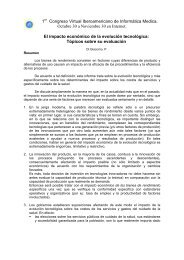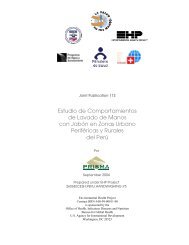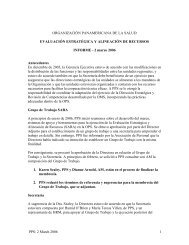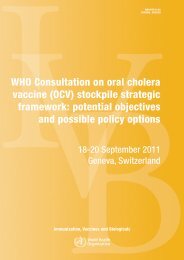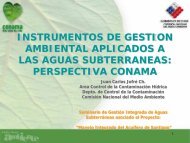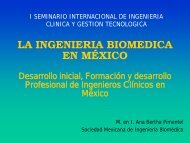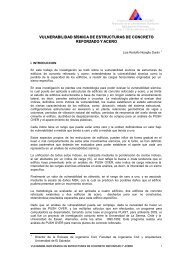a database of the National Library of M
a database of the National Library of M
a database of the National Library of M
You also want an ePaper? Increase the reach of your titles
YUMPU automatically turns print PDFs into web optimized ePapers that Google loves.
aberration was 8.5%. Chromatid breaks were <strong>the</strong> predominant type <strong>of</strong>aberration and represented 61.2% <strong>of</strong> all breaks. Chromosome breaks,dicentric chromosomes and acentric fragments were also present. Theresults <strong>of</strong> <strong>the</strong> micronucleus and chromosome aberration assays werecomparable. Increasing numbers <strong>of</strong> micronuclei per binucleated cell andincreased numbers <strong>of</strong> cells with more than one micronucleus were followedby a higher percentage <strong>of</strong> chromosome aberrations or more severechromosomal damages. Sister chromatid exchange frequencies were alsoincreased, with a mean group value <strong>of</strong> 9.2 per cell. Individual range <strong>of</strong>sister chromatid exchange frequencies was 4 to 27 per cell. [Fucic A etal; Mutation Research 242 (4): 265-70 (1990)]**PEER REVIEWED**The methods and results <strong>of</strong> a collaborative study, coordinated by <strong>the</strong>International Agency for Research on Cancer and conducted in many researchcenters in Europe, were examined. The study examined <strong>the</strong> cancer incidenceand mortality among vinyl chloride workers. A total <strong>of</strong> 14,351 subjectswere contributed to <strong>the</strong> combined data base. The results indicated thatvinyl chloride is associated with an increase in liver cancer incidence.An exposure response relationship was noted for both ranked and estimatedcumulative exposure. The relationship was even more evident when onlyliver angiosarcoma was analyzed. No significant excess <strong>of</strong> mortality wasobserved for <strong>the</strong> o<strong>the</strong>r sites suspected a-priori to be affected by vinylchloride exposure. While <strong>the</strong> incidence <strong>of</strong> lung cancer was slightlyincreased, nei<strong>the</strong>r it nor lung cancer mortality appeared to be associatedwith any <strong>of</strong> <strong>the</strong> exposure variables. Brain cancer and lymphosarcomamortality, while demonstrating slight increases, did not appear to beconsistently associated with exposure, although <strong>the</strong> small numbersprohibited firm conclusions. An increased risk <strong>of</strong> bladder cancer andmelanoma <strong>of</strong> <strong>the</strong> skin was detected which did not appear to be related toexposure in that <strong>the</strong> association with employment in <strong>the</strong> vinyl chlorideindustry was confined to one country only. No increased mortality wasobserved for <strong>the</strong> o<strong>the</strong>r main causes <strong>of</strong> death. [Simonato L et al;Scandinavian Journal <strong>of</strong> Work, Environment and Health 17 (3): 159-69(1991)]**PEER REVIEWED**Sister chromatid exchanges and micronuclei frequency in workers exposed tovinyl chloride monomer were measured to determine which <strong>of</strong> <strong>the</strong> twoendpoints was <strong>the</strong> most selective in this occupational setting. Bloodsamples were obtained from 93 human males, all <strong>of</strong> whom were nonsmokers.The occupationally exposed group, 52 workers, was divided into twosubgroups based on workplace and <strong>the</strong> vinyl chloride monomer concentrationin <strong>the</strong> air during <strong>the</strong> 4 weeks prior to sampling. One subgroup, exposed toconcentrations <strong>of</strong> 1.3 to 16.69 ppm, consisted <strong>of</strong> 31 workers aged 24 to 54yr at a manufacturing facility. The o<strong>the</strong>r subgroup contained 21 workerswho were exposed to concentrations <strong>of</strong> 0.3 to 7.3 ppm on <strong>the</strong> polymerizationcontrol lines. The comparison group included 41 unexposed men. Both sisterchromatid exchange and micronuclei were increased among exposed workers.The sister chromatid exchanges frequency was increased 61.8% abovecomparisons. It was possible to discriminate between <strong>the</strong> high exposure andlow exposure subgroups using sister chromatid exchanges. A significantincrease in micronuclei frequency was seen in <strong>the</strong> exposed group; <strong>the</strong>re wasa significant difference between <strong>the</strong> high exposure and low exposuresubgroups, but not between <strong>the</strong> comparison group and <strong>the</strong> low exposuresubgroup. Sister chromatid exchange was <strong>the</strong> more sensitive endpoint forindicating a biological response. However, <strong>the</strong> authors point out thatmethods for restricting <strong>the</strong> micromuclei analysis to only cells at riskwere not used. [Sinues B et al; Toxicology and Applied Pharmacology 108



